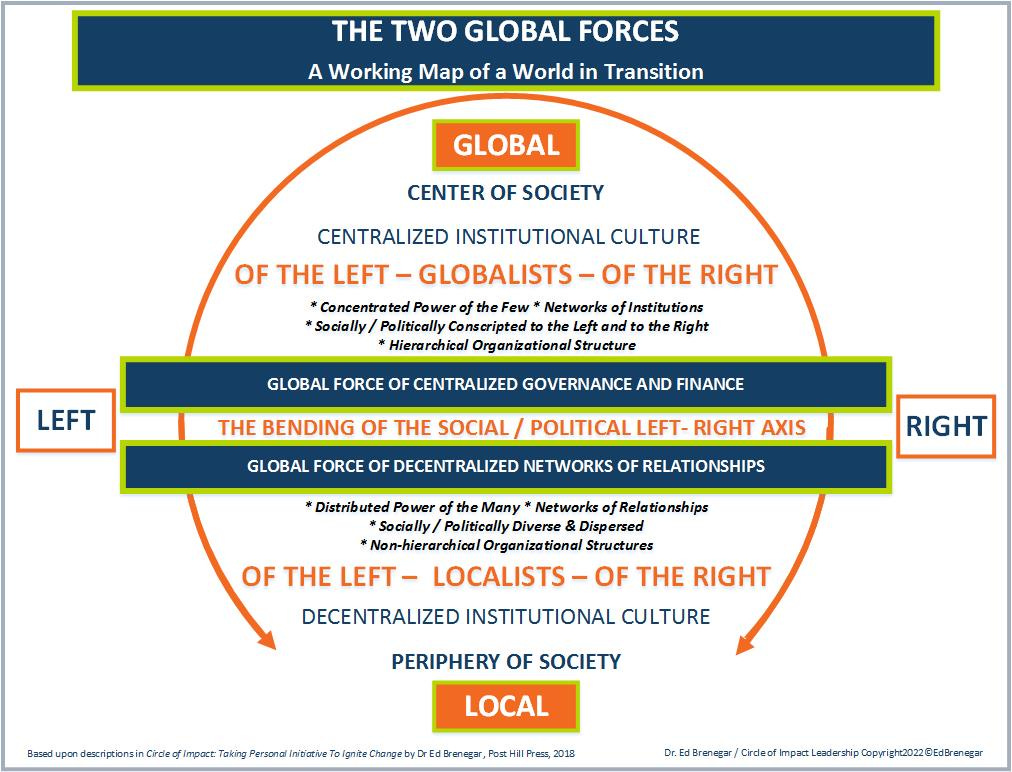We are living in a time of transition marked by significant changes that affect us individually and our local communities. Whether the crisis is the coronavirus pandemic, accelerating inflation driving fuel and food costs up, the rising crime and the decline of the quality of life in once prominent cities, or the global spread of Freedom Convoys to protest the rise of authoritarian government policies, the world is in a state of dramatic and disruptive change.
In my book, Circle of Impact: Taking Personal Initiative to Ignite Change, I write about how the Two Global Forces that I featured in part one of this series are vehicles for change to take place. The following selections from the book, pp.152-157, describe this occurrence.
Two Global Forces of Change
Think about the transition that we are experiencing as the product of an increasing capacity of people and organizations to do more, reach further, and solve problems that have been present for millennia. This historic moment of transition is represented by two global trends. One is older, more institutional, now reaching its apex, the other is just emerging to become the guiding trend for the future. I described these two forces of change earlier as between structures of centralized control and decentralized networks of relationships.
The older force of change is that of global institutions of governance and finance. These are the organizations that were created in the aftermath of two world wars to promote prosperity and peace in the world. These global organizations came into being because world leaders lacked the confidence that their nations could, on their own, create a peaceful, prosperous world.
The other force of change is found in networks of relationships, where personal initiative for impact finds its best expression. The emergence of digital technology is a key element in the capacity of you and me, and billions of people around the world, to interact in ways that advance our shared commitment to make a difference in the world. Today, national and geographic boundaries are no longer obstacles to our individual desires to also bring peace and prosperity to the world.
The interaction between these two forces is a historic moment of transition. It is important that we understand why this transition is taking place.
The Force of Global Integration
For the past century, integrating national efforts for peace and prosperity into global organizations has been an ongoing process. The aim is to integrate as many functions of society into a seamless efficient system operating through global institutions of governance and finance.
As these organizations grew larger and more expansive, their connection to people in the localness of their lives became more distant. The larger the organization, the more difficult to recognize the individual differences that distinguish people, communities, or nations. Whether intentional or not, the system’s impetus is towards a one-size-fits-all approach to the solution of problems. As a system of development, it succeeded in places where local cultures were ready.
The limitation of these organizations is in their hierarchical nature. Whether the hierarchy serves a thousand people or seven billion, all hierarchies are dependent on a small group of leaders to have the knowledge, the skills, the wisdom, and the character to make decisions that are in the best interest of the constituencies they serve. For several millennia hierarchical structure has defined the nature of leadership, where we find a few leaders ruling over their many subjects. The inherent weakness of hierarchy is that it is only as strong as the wisdom and character of the senior leader.
Hierarchy requires order to succeed. To create order on a large scale requires a structure for control over the hundreds or thousands of people under its leadership. To release control creates an opening for individual initiative and collaboration. This is the transition point that modern organizations have been passing through for at least a generation. The world we are living in today is one where the knowledge, skills, tools, and, to a certain extent, the resources for personal initiative, have become available to everyone. Today, institutional control over all the facets under your authority has become more difficult and less certain as the opinions of people through social media can overnight cause the termination of a leader or prominent cultural figure. This loss of control is a mark of a transition that is irreversible in my opinion.
The Force of Personal Initiative
The second force of change is reflected in the native desire of individuals on a global scale to live lives and do work that matters to them and for their communities. Their acts of human initiative operate within the context of relationships of trust and mutuality. The difference between these relationships and those within the institutions of global governance and finance is that these networks of relationships have no institutional mandate. Their relationships are free to form, to grow for a season, and then to recede or disband as other relationships emerge to take their place.
For many of us, these relationships originate online through social media platforms. We gather around common values, shared experiences and perspectives about life and work that transcend our national and cultural boundaries. This is my own experience as a global citizen. It is not that we rally to a global cause, but rather we move toward people and opportunities where our desire to be persons of impact can be realized.
These global networks of relationships are possible because the technology of handheld devices makes it possible to communicate with anyone anywhere there is a Wi-Fi connection. The obstacles to having personal impact in the lives of people globally have been reduced to a minimum. Networks of relationships, as a result, thrive in the context of interaction where we can contribute to one another’s lives.
A core principle of the Circle of Impact is that all leadership begins with personal initiative. Its purpose is to create impact for the benefit of our local communities. Looking at this idea in the context of the relationships that social media fosters today, it is apparent that we are only in the first stages of recognizing the value of having boundary-free global relationships. I am convinced that this is because we are also in the first stages of people beginning to see that their lives can be defined by their actions, rather than by their association to an ideology or movement.
Chinese artist and activist Ai Weiwei aptly describes this perspective of living today. “Your own acts tell the world who you are and what kind of society you think it should be.” This is the transition that is taking place which is entering us into a world far different than the one our parents and grandparents knew. Through the power of digital technology to connect us together, we can find the advice, the resources, and the motivation that we need to initiate positive change in the world.
Many of our acts of personal initiative are done without recognition.
The gift of a meal to a hungry person.
The mentoring that takes place in schools, sports, and in youth club programs.
The volunteering that takes place in local communities through religious congregations and community nonprofits.
Entrepreneurial programs to train and develop the leadership of new businesses.
Event planners and consultants who bring people together to raise financial support for local programs. The Structure Dimension—Creating Impact That Matters 157
Meetings over coffee where community understanding and healing can begin to take place.
In each situation, it starts with a person taking initiative. Then it grows through the networks of relationships that emerge at both the local and global level.
For organizations, small and large, local or global, the character of people is becoming a leadership differentiator. When we take leadership initiative to solve a problem, to collaborate across institutional boundaries or create new processes of work, we are taking action to create a better future. When an organization encourages and creates the space for people to take personal initiative, a release of energy and productivity takes place. The potential hidden in people can be tapped into to advance a business. Instead of leadership being a top-down role within the structure of the organization, this is where a bottom-up culture of leadership grows to define the company or a community.
We are in the midst of a great transition as a global society. The hierarchical nature of global society that has existed for many millennia is changing to one where each of us can be persons of impact as leaders both in our local communities and through our relationships with people globally.
The Transition That We Are In
It is easy to get wrapped up with the concerns of people who we only know through social media. If what I see transpiring, the eventual decline of centralized institutions of governance and finance and the rise of local community-centered decentralized networks of relationships, then most of us need to focus on how we can turn the assets of our own talent and experience into contributions that make a difference in our local communities.
In the last part of this three-part series on the Two Global Forces, I will look at how we can take personal initiative that makes a difference that matters and which also can have an impact at the global level.
Two Global Forces in Conflict Series
Part One: The Nature of the Conflict





